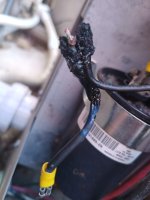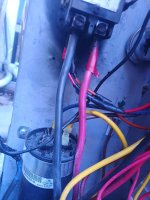Strange question but it's the second time that one of the wires that's between the relay (with the incoming 240V from the house) and the main capacitor (I think it's a capacitor) melts / explodes at the spade connector (it's a thick blue wire). Just so it's clear, this is a wire that comes in the unit from the factory, not the incoming 240V power that's added and used to supply electricity. Last time, I just replaced the spade connector and it was working until now but has failed again a few days ago.
Has anyone experienced this? Should I maybe replace the wire with a heavier gauge one? (Can't do much with the spade connector since it's it's on the relay and on the capacitor). Any other suggestions?
The location.jpg picture shows you where they connect to the relay (both attach behind the red wire (which is the incoming power)) and the one that melts goes down to the top left of the capacitor. The wire.jpg picture shows the wire and the sheilding basically melted and stuck to the wire that's next to it.
Let us know. Thanks, Mike
Has anyone experienced this? Should I maybe replace the wire with a heavier gauge one? (Can't do much with the spade connector since it's it's on the relay and on the capacitor). Any other suggestions?
The location.jpg picture shows you where they connect to the relay (both attach behind the red wire (which is the incoming power)) and the one that melts goes down to the top left of the capacitor. The wire.jpg picture shows the wire and the sheilding basically melted and stuck to the wire that's next to it.
Let us know. Thanks, Mike
Attachments
Last edited:



